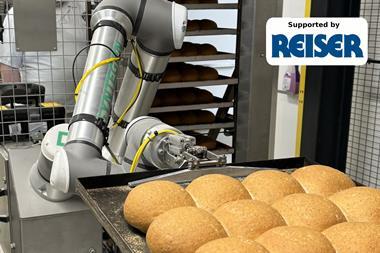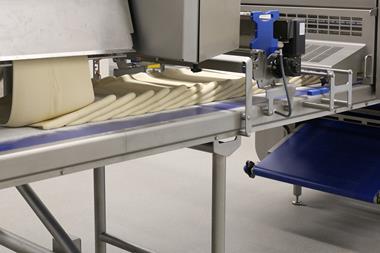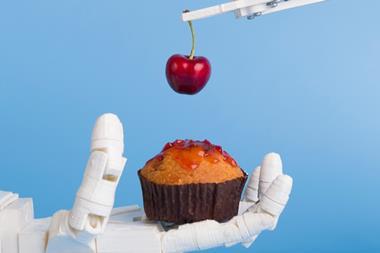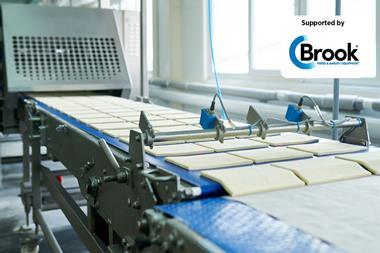Modern sheeting and laminating equipment can now handle almost any type of dough, say suppliers, but bakers should ensure they invest in the kit that really suits their needs
Brits’ appetite for artisan-style bread shows no sign of abating – just look at the ever-growing range of seeded, sourdough and flatbreads gracing supermarket bakery fixtures.
The demand extends to wrapped bread, with values sales of seeded loaves soaring 7.9% in a virtually static overall bread market (Kantar Worldpanel 52 w/e 21 May 2017). Little wonder, then, that automating the production of artisan-style bread is currently a focus of many players in the baking industry.
“The key to success when working with bread doughs is gentle handling throughout the process,” says Richard Tearle, general manager at Rondo. He adds that by using the latest sheeting, curling and moulding technology, it is possible to produce artisanal-style bread products in high volume.
The Rondo equipment line-up includes the Smartline, which features a multi-roller unit that enables the angle of the head to be set to an optimum position to handle different dough types.
“The dough is gently sheeted without damaging the structure, producing products that have a real artisan appearance,” adds Tearle.
Sheeting systems can handle a wide variety of dough types, from ‘green’ to pre-fermented, at high capacities, according to Rademaker. The supplier has adapted its sheeting equipment to make it more suitable for artisan-style bread production.
“By using stress-free dough sheeters and laminating technology, you can achieve basically any dough and bread structure desired,” says Rademaker UK, Ireland and South Africa sales director Joris Ros. “Because artisan-type dough contains a higher water percentage than ‘normal’ dough, this has an effect on the equipment.”
His company produces the Crusto bread line concept, which enables traditional bread types and artisan-style breads to be produced on one sheeting system, and can handle the majority of doughs, including those for breads with a high water or low salt content, gluten-free, pre-fermented and sponge.
“If you want to produce tin breads, we focus on achieving a fine and consistent crumb structure, whereas with the high-water absorption artisan breads we focus on obtaining a light, authentic and open bread structure,” says Ros.
Dough can be guided through the Crusto line directly or after a long rest time, without adding stress into the dough.
“The dough structure remains undamaged and with this, the dough development is retained,” adds Ros. Alongside demand for more natural, artisan bread has come interest in simpler ingredients lists, a trend that presents little problem for sheeters according to manufacturers.
“The drive towards clean label means longer processes, and these require no-stress sheeters,” says Ros. “This has been happening for the past few years and we have introduced our DSS (no stress) sheeter, which is ideal for pre-fermented doughs of up to 80% water content.”
John Edmondson, sales director at Fritsch, says demand for clean-label products is not really affecting sheeting technology. “The sheeting lines are already able to manage the processing of a great range of doughs and recipes, with artificial as well as clean-label ingredients.”
And, generally speaking, there have been no major changes to the sheeting process, says Tromp Group UK and Ireland sales manager David Rowland, who adds that large bakery businesses are trialling sheeting technology to create artisan-style products at high volume.
“Sheeting processes have always followed the basic principles,” he says. “However, dough temperature control and proving methods have evolved so as to adapt to throughput and quality demands.”
Meanwhile, Fritsch says it has a wide range of dough processing machines to imitate the artisan process.
“With the sheeting lines, we enable our customers to process dough types with long pre-proofing and/or very high water content (up to 85% water), which are very hard to handle manually,” adds Edmondson.
Kaak Group’s sales and marketing specialist David Marsh says dough sheeting and subsequent forming systems have the ability to manipulate, form and shape dough to reproduce the handmade product – and are a long way from the dough brakes and laminators used for puff pastry or other similar products.
“These bread dough sheeting systems meet the needs of high water content, highly gassed doughs, preserving their essential characteristics through the make-up line onto the peel board or even into the bread tin,” he adds.
Kaak Group – previously known in the UK as Benier – offers the DrieM range. This includes the six-roll artisan dough DrieMer sheeting head that continually and automatically adjusts its sheeting roll positions and drives to optimise dough feed and the dough structure.
“Thought has been given to the subsequent sheeting systems to ensure that dough is not stretched or stressed beyond what the final product requires,” says Marsh.
DrieM has also developed dough ball systems that mimic the hand-rounded boule texture by adjusting the rounding cup parameters throughout the cycle. Marsh claims that, in this respect, there are no products that dough sheet systems cannot produce. He adds that, given the huge breadth of DrieM line product capabilities, the possibilities of new product development (NPD) are endless.
It’s a view echoed by Tromp’s Rowland, who says that because sheeting technology supports weak flours and higher water absorption, this offers versatility to develop new lines.
Ros agrees about the equipment’s flexibility, saying it offers a range of possibilities for different production methods and new products.
“We have specifically chosen sheeting technology because of the flexibility it offers. Over the years we have seen that bakers who have chosen sheeting technology have been able to be very innovative because their sheeting line is able to support their needs.”
He believes sheeting will become the standard in the baking industry because it has proven to be the most effective system in the market.
Meanwhile, Edmondson says Fritsch’s sheeting technology means the company can offer customers choices depending upon their budget and their product portfolio.
Laminating systems also have a role to play in NPD, say suppliers.
“Starting from a laminated band of dough, it can be possible to obtain even a dough ball with a proper attachment, so that, in the future, it could be easier to develop traditional products with a laminating line with less limit in term of product dimension and variety,” says Luca Clementi, international sales director at Italian equipment supplier Canol.
Canol says its laminating lines are suitable for continuous production of doughs including puff, Danish and croissant, and avoid stress or tension on the dough to ensure a quality product.
“Small changes have been made on the sheeting line to reduce the stress of the laminating process, where the key is to cut the tension and preserve the fermentation process of the dough,” adds Clementi.
Among businesses benefiting from laminating technology is Scottish firm Bells Professional Pastry, which last year invested £1m in a Rondo MLC ‘U’ pastry laminator, feeding a Starline make-up line. The investment was made to help the company compete for high-volume commercial pastry orders, and means it can now manufacture 500-600kg of product a day, using butter-enriched, shortcrust and puff pastry in various shapes and sizes.
Manchester-based Custom Cookie Co recently took delivery of a Tromp laminator that it uses for making Scotch and French puff pastry. The company has found pastry produced using the laminator much more consistent than its hand-made version.
“It gives a greater degree of ‘puff’,” says Custom Cookie Co founder Alli Cardona. “This, however brings its own problems of flakiness and damage, and hence we are working on just the right balance.”
She adds that the equipment is saving time and labour, and the business is looking at adjusting its production schedules to accommodate larger-volume pastry production on a less frequent basis. While laminating is most closely associated with pastry and croissants, it plays a vital role in cracker manufacturing. Essentially, there are two cracker types – the classic fermented, laminated crackers such as cream crackers and soda crackers – and the enzyme modified snack crackers such as Ritz or TUC. The laminated cracker is more challenging because it requires the creation of separate layers of dough. These are then sheeted by gauge rolls before being cut into individual pieces for baking.
Spooner Vicars has designed the Asymmetric 4-roll sheeter for this, which consists of four rollers arranged in an asymmetric cascade.
“This design allows the dough to be compacted in two separate chambers and reduced in thickness twice in order to create a very uniform dough sheet,” says sales director Gerard Nelson.
“The laminator then passes the sheet through two sets of gauge rolls each with the longest relaxation conveyors in the industry, and these allow the dough to release the stresses generated. This prevents the crackers from shrinking and distorting during the baking process.”
Whether you are developing new product lines, looking to improve efficiency or ensuring greater consistency, sheeting equipment can play a major role.
Buying your first sheeting equipment
If you are planning to buy your first sheeter, how much you need to spend will depend on the hourly or daily throughput of your business.
John Edmondson, sales director at Fritsch UK, says investment could start as low as the price of a medium-sized car and rise up to hundreds of thousands of pounds.
Sheeting could initially be done with a craftsman machine to handle 10-15kg dough blocks, he suggests, followed by a single sheeting line to produce a finished dough sheet.
“Depending on the demands regarding output per hour, bakers should look for semi-automatic laminating machines, more output with a mid-sized sheeting section with industrial technology or a complete mid-sized laminating line with integrated folding systems,” adds Edmondson.
David Rowland, sales manager for the UK and Ireland at Tromp Group, says bakers should avoid too much complexity for their first sheeting line and instead go for simple, but smart, solutions.
Tromp Group offers a semi-automatic laminator that allows small businesses to trial a concept line to achieve the benefits while retaining some manual interventions.
“Our sheeting solutions offer product consistency and efficiency which cannot be achieved with a manual process,” explains Rowland.
Richard Tearle of Rondo suggests an Econom table-top reversible sheeter as the first step after the rolling pin, as these are used in hotels and small bakeries.
“As businesses grow, they can move on to programmable sheeters and make-up tables,” he says.
Specially engineered production equipment, with the focus on profitability and matching product specification and quality, would have the most benefits, says Fritsch director Edmondson.
Alli Cardona of Manchester-based business Custom Cookie Co, which recently started using a laminator for the first time, advises first-time users look at other bakers’ methods.
“Its helpful in learning what will or won’t work for you taking into consideration space, production volumes, investment etc,” she says.
Saving labour with sheeting
Brexit has raised industry-wide concerns about the possibility of staff shortages – and sheeting equipment could have a role to play in reducing bakeries’ dependence on manual labour.
Sheeting and other forms of automation will reduce staff levels, says Rademaker UK, Ireland and South Africa sales director Joris Ros. He notes some businesses have opted for automation because of creeping costs, such as the introduction of the workplace pension and higher minimum wages.
As such, he believes sheeting and laminating will become more automated in the future. “The higher the level of automation, the more efficiently a bakery can operate. Flexibility of the lines has greatly improved in recent years and the product quality is good, if not better than when made in the more traditional way.”
Fritsch sales director John Edmondson says sheeting lines offer the best opportunities for bakeries to save resources in the core production process. “Most of the lines run with only one operator, with their main job being to observe the line and keep up with the demand for materials,” he adds. “Industrial lines are operable with one or two people, meaning easy handling, simple and easy cleaning and automation changeover.”
Tromp Group has installed dough-sheeting lines that have resulted in a 50% cut in operator levels. “Sheeting technology is a more efficient and less labour-intensive process,” notes sales manager David Rowland, adding that demand for multiple SKUs and fully flexible lines will force further automation in sheeting.
Cutting down on labour is one thing, but there are no short cuts when it comes to hygiene, which is why DrieM equipment is all wash-down as standard, says its supplier Kaak Group. “Lines are fully automated, by just one operative,” explains David Marsh, sales and marketing specialist at Kaak Group. “DrieM has produced bread dough systems rated up to 10,000kg an hour where the operator interface is a simple touchscreen repeated at a few points along the line.”
Waste needs to be minimised, and DrieM has developed in-line checkweighers to control the weight of the dough sheet or pieces without the need for constant operator adjustments.
Case study: Mono serves up gluten-free solution for Panini’s
Swansea-based sandwich firm Panini’s needed to invest in new equipment after deciding to open a gluten-free bakery.
Giovanni Amieni, who runs the company with his brother Fabrizio, did his homework, researching what he needed and who could supply it.
“More and more customers are looking for a gluten-free option and, due to this increasing demand, we decided we needed to invest in a new gluten-free bakery that naturally had to be physically divorced from our main production facility,” he says.
This required a sizeable investment and, after receiving a number of quotations from various suppliers, Panini’s decided to go with Mono.
“They weren’t interested in just selling us equipment, but were actively interested in helping us not only develop our knowledge and expertise in setting up the gluten-free bakery, but also in helping us to develop and refine our range of gluten-free products,” adds Amieni.
Mono was the sole supplier of equipment for the gluten-free venture, which included mixers, a Canol sheeting line with satellite head and Mono rack ovens.
“Working with gluten-free dough means you are restricted equipment-wise so we had to get the best line we could find – and that was the Canol one. It’s a great machine and does exactly what we need,” says Giovanni. “I’d advise anyone thinking of investing in this type of equipment to work with the manufacturer and make sure they get what works for them and not just what the manufacturer wants to sell them.”
Chris Huish, independent sales director at Mono, says he has worked with the Amieni brothers since 2005, when he sold them one of Mono’s Fusion bread plants.
“I’ve since worked with Panini’s in developing a superb range of gluten-free products that deliver a ‘normal’ bread taste, which is so sadly missing in many of the products available on the market today.”
Panini’s gluten-free bakery has only been operational for a few months, but the firm reports that it has received positive feedback so far and that business is building.
Sheeting suppliers get to grips with sticky free-from situations
Almost a quarter of British consumers are now buying gluten-free products, according to government figures, and 16% are opting for wheat-free items.
That’s the good news. The less so good news is the technical challenge involved in gluten-free production given the key role gluten plays in the elasticity of dough.
“Gluten-free dough is extremely sticky, which makes the production process far more difficult than normal dough types,” explains Joris Ros, sales director UK, Ireland and South Africa, for Rademaker.
He adds, however, that his company has years of experience in bread, pizza, Danish and puff pastry gluten-free production and, as a result, has partnered with gluten-free bakeries throughout the world.
“A Rademaker gluten-free production line is equipped with special tools capable of handling these extremely sticky doughs, enabling consistent and efficient gluten-free production,” Ros explains.
Tromp Group also says it has overcome the challenges that the high water content and difficult dough structure create for sheeting equipment.
“We have successfully overcome these issues with the recently installed gluten-free sheeting lines,” says David Rowland, sales manager for the UK and Ireland. “These are very resilient to dough types and our success has been achieved by working with bakers to test the benefits with different minor ingredients.”
At Kaak Group, the answer has been the development of the DrieM stress-free dough make-up line that, according to sales and marketing specialist David Marsh, has made it easier to address the challenges of gluten free. “Its patented multi-roller design is uniquely able to address some of these aspects of handling gluten-free doughs.”
Richard Tearle, general manager at Rondo, says his business has worked with many of the UK’s free-from manufacturers in their test facilities in Switzerland to develop doughs capable of running on sheeting and make-up lines.
With free-from products in mind, Ros at Rademaker advises bakers choose an efficient and flexible sheeting line that can be adjusted.
“Also choose a manufacturer that is able to prove they control the required production process, especially in the case of very difficult and special processes like gluten-free, free-from and pre-fermentation production,” he adds.


























No comments yet